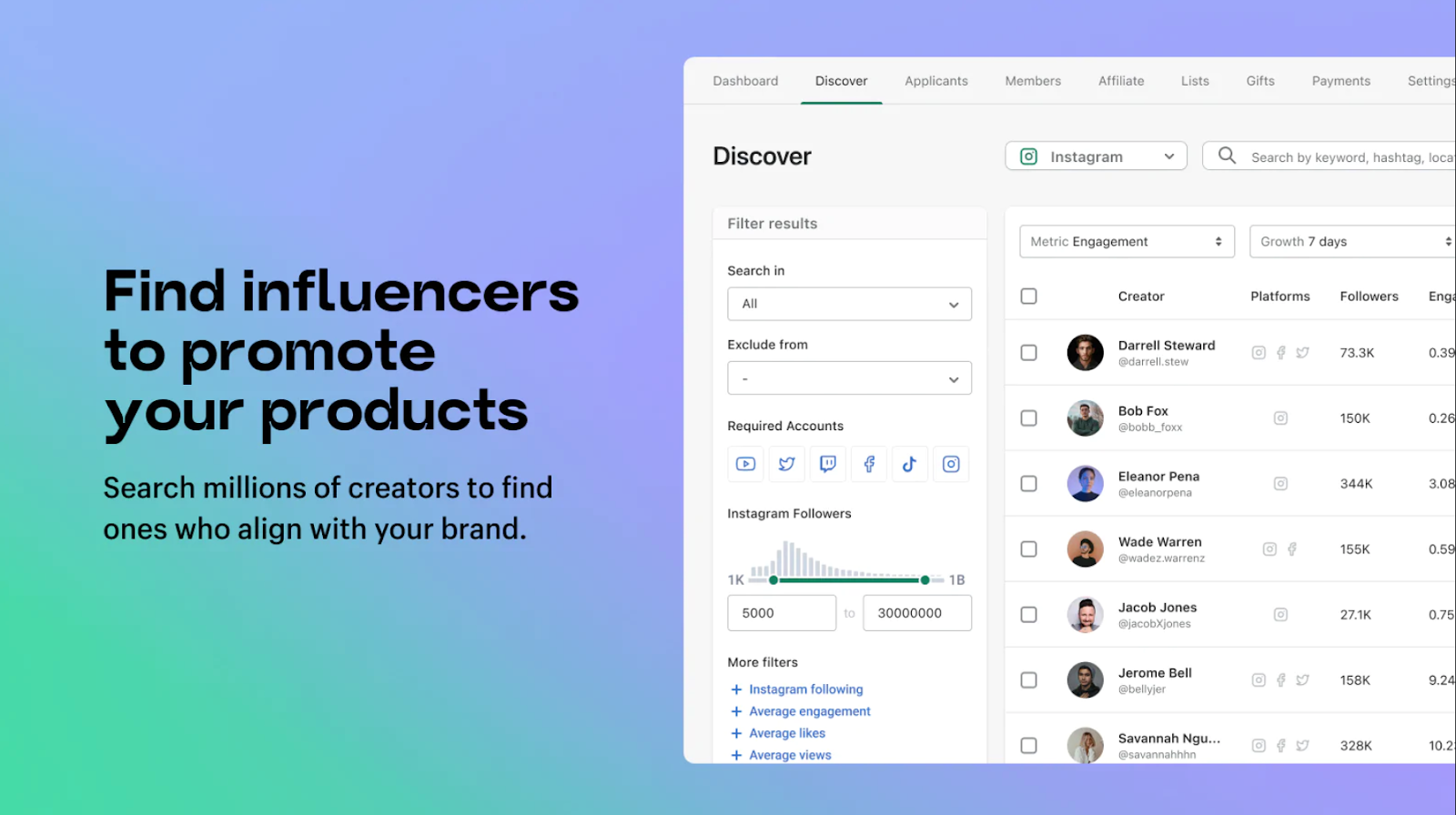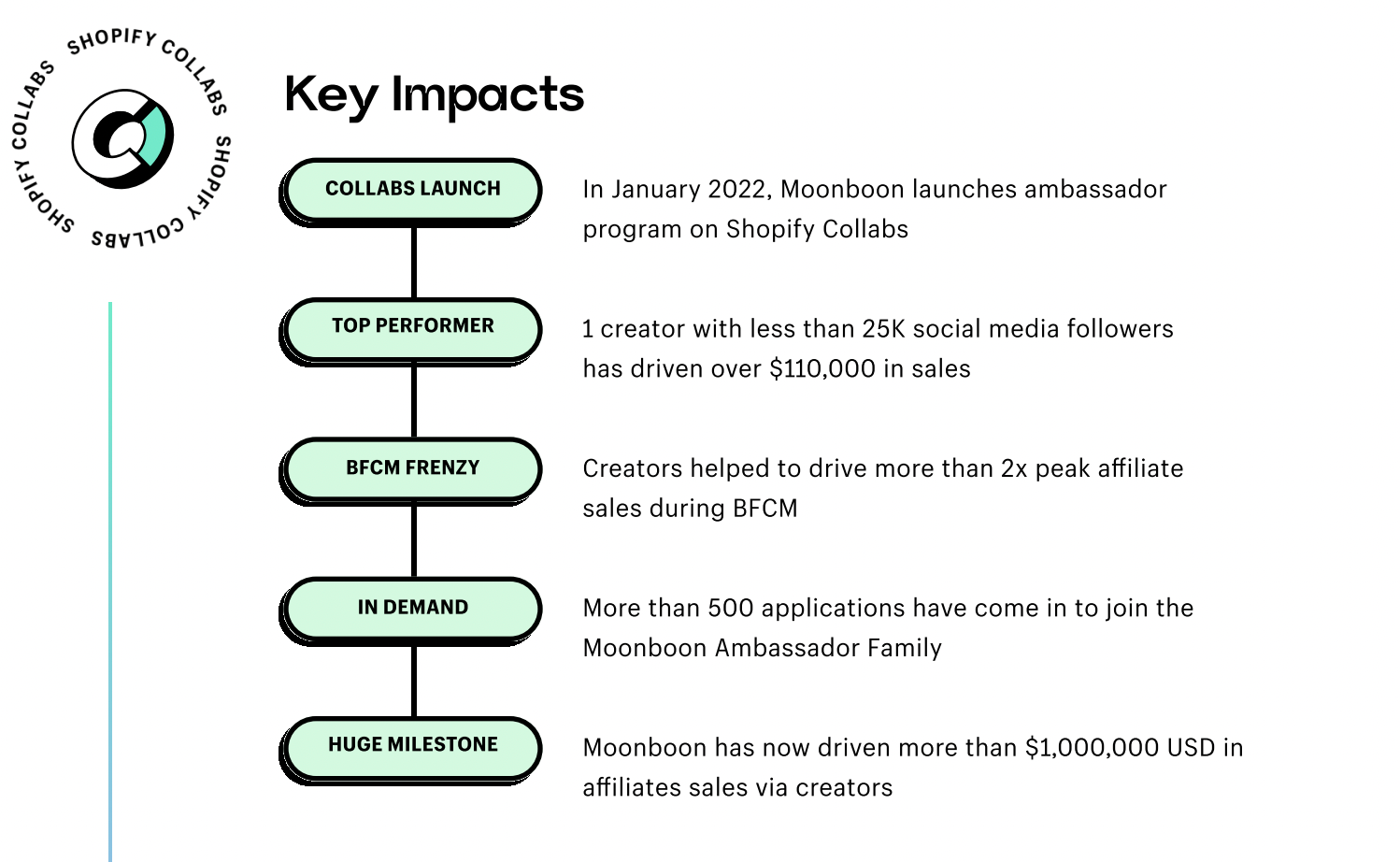Influencer marketing is no longer a passing trend. The industry is set to generate$21.1 billionin 2023, withmore than halfof ecommerce brands spending at least 20% of their marketing budget on social media influencers.
It makes sense: Influencers have established audiences of people who know, like, and trust them. That’s why61% of consumerstrust recommendations from their favorite influencers. Ecommerce brands that pay to tap into that network can skyrocket sales—especially if there’s overlap between an influencer and brand’s audience.
If you’re still sitting on the sidelines and feeling unsure of how to approach an ecommerce influencer marketing strategy, you’re in the right place.
This guide shares strategies for leveraging the power of social media influencers to drive ecommerce sales, from identifying the right influencers to creating effective campaigns and measuring results.
Table of contents
- What is influencer marketing?
- How to find ecommerce influencers
- Ecommerce influencer marketing tools
- Pros and cons of ecommerce influencer marketing
- How to set up winning influencer campaigns
- Ecommerce influencer marketing FAQ
What is influencer marketing?
Influencer marketing is a type of social media marketing, where a business collaborates with an influencer to promote its products or services to their audience. Influencers usually have a large following of engaged fans. Brands whose target audience matches the influencer’s following can pay the influencer to promote their products in a sponsored post that reaches their audience.
Ecommerce influencers are often grouped based on their follower count on a single social media platform:
- Nano-influencers:1,000 to 9,999
- Micro-influencers:10,000 to 99,999
- Mid-tier influencers:100,000 to 499,999
- Macro-influencers:500,000 to 1 million
- Mega or celebrity influencers:More than 1 million
How to find ecommerce influencers
Twenty-seven percent of marketersagree it’s hard to find the right influencers for a marketing campaign. This is not surprising considering that the number of social media influencers out there makes it challenging to decide who you should work with.
Techniques to find influencers to collaborate with include:
- Hashtag research.Studying the top hashtags within your industry is a good way to spot and shortlist influencers in your niche.
- Competitor analysis.What kind of influencers are your competitors partnering with? See who and how your key competitors leverage Instagram influencers, and see what you can glean from that research.
- Influencer marketing platforms.If you find research tiring or you’re strapped for time, consider using aninfluencer marketingplatform. Tools likeShopify Collabscan help you partner with niche influencers while removing some of the research work.
Monitor brand mentions.Use tools likeMention MeorBrandwatchto discover natural instances of people mentioning your brand across all social media platforms. These people often make the best influencers, since they already know your brand and identify as a loyal customer.

Shopify Collabs is a tool to help ecommerce brands find influencers.
Not every influencer that appears throughout your discovery process will be a good fit for your ecommerce brand. It is important to evaluate these three factors when deciding who to work with:
1.Brand fit
Brand fit is crucial, as you want to partner with someone who reflects your brand values and ethos. By working with an influencer who aligns with your brand, partner content is more likely to connect with the audience authentically.
How do you determine if an ecommerce influencer is right for your brand? Reach out to each influencer and request a media kit—a one-page document that details the influencers’ audience demographics and rates. Initiate a conversation with those who have the closest overlap to your brand’s customer persona.
Makeup and skin care brandGlossierOB欧宝娱乐APP在社交媒体和已经开始an active and engaged Instagram audience of 2.8 million. It focuses on marketing via micro-influencers to develop a cult-like following.
Through its partnership program, it works with influencers who match its brand values and are known in the beauty social space. Influencer Julia Kong has more than 50,000 followers on her Instagram, which showcases their love of fashion and beauty, along with vacations and life events like setting up their first apartment. An engaged following and authentic moments match Glossier’s brand values and aesthetic, making it a strong partnership.
2. Engagement rate
The “influence” of an influencer is often defined by how their audience engages with them. Don’t be fooled by the engagement an influencer gets on an average post—the engagement rate on sponsored posts tends to be lower.
To establish a more accurate engagement rate, follow these steps:
- Pick three of their recent promotional posts as a baseline. You might need to dig deep to find branded hashtags or links, as promotional posts are not always obvious.
- Add the number of likes and comments and divide it by the follower count.
This number will not give you the true reach of the post (which is calculated by adding the likes, comments, and saves divided by the follower count), as this data is not public. Even without the detailed data, this approach can help you discern an influencer’s engagement averages.
Joel Contartese, marketing director at Instaco, has managed more than $10 million in influencer spending. Even with experience, Joel finds the numbers around influencer marketing can be surprising.
“The one thing you absolutely must know about influencer marketing is that the numbers don’t always tell the whole story,” Joel says. “After spending millions on ‘celebrities,’ I’ve seen better results from influencers with a smaller but much more niched following than from the widely popular ones.”
Keep in mind, compared to macro-influencers,micro-influencers tend to generate better resultsfor brands. Bigger isn’t necessarily better in the influencer world.
3. Previous sponsorships
The average influencer works withup to 10 brandssimultaneously. Getting to know their track record around past partnerships is another way to evaluate partners. Ask questions like: What kind of brands did they partner with in the past six to 12 months? Do they maintain consistency around the type of sponsors they work with? These insights will help you find highly relevant partners that do quality work.
“Brands should prioritize efficient, high-quality creator discovery with large opt-in creator networks,” says Blaire Kang McClure, associate product marketing manager atImpact. “An opt-in creator network of prequalified partners is a key tool for rapidly identifying the right creators for campaign work. Brands can proactively discover influencers, searching by data points such as audience size, geography, niche, etc.”
Footwear companyAllbirds使用高质量的微观和宏观rs who have a history of brand partnerships. To showcase the versatility of its sneakers, it worked with New York influencer An Trieu on a Wes Anderson–inspired trip to the farmers market. An has experience working with various brands, from bedding to alcohol to makeup and even movers.
Ecommerce influencer marketing tools
从发现影响到监测结果s of your campaign, here are some popular ecommerce influencer marketing tools designed to make the process easier.
Shopify Collabs
This influencer marketing platform helps ecommerce brands identify influencers. Browse creators of all sizes, across all major social media platforms, and find the best influencer for your brand. Collabs is free for Shopify merchants to install.
Buzzsumo
Track natural mentions of your brands and products and reach out to creators with a collaboration opportunity. Buzzsumo also allows you to research popular topics amongst your target audience, including the influencer content they’re engaging with.
HypeAuditor
Powered by artificial intelligence, HypeAuditor helps analyze the influencer accounts on your shortlist. See an unbiased report of each influencer’s audience demographic, authenticity score (which shows the ratio of real to fake followers), and growth rate.
Pitchbox
This pitching software helps you track influencer outreach. Keep tabs on how many emails you’ve sent, those you’re awaiting a reply from, and deals in progress—without sticky notes or mental reminders.
GRIN
Produce influencer marketing reports within your Shopify dashboard. See the number of likes, shares, comments, and engagement rate across every sponsored post you’ve commissioned.
Moonboonis one merchant that put Shopify Collabs into action. Its baby sleep accessories fit the Scandinavian interiors trend that’s taken social media by storm, making influencer marketing a natural extension of its ecommerce marketing strategy.
To date, Moonboon’s 300 creators havedriven more than $1 million in net sales. Its ecommerce influencer marketing program has an impressive ROI of 6.5 times.

Moonboon’s influencer program, supported by Shopify Collabs.
Pros and cons of ecommerce influencer marketing
There are many benefits ecommerce brands can expect to achieve with influencer marketing campaigns:
- Relevance.The best-fit ecommerce influencers ideally share the same audience as your brand, which makes for a highly relevant partnership. Your target audience already knows, likes, and trusts the influencers recommending your products, making them more likely to buy.
- Cost-effectiveness.In the past, brands often allocated a huge chunk of their marketing budget to just one celebrity endorsement. But with the rise of thecreator economy(especially micro-influencers on TikTok), brands can achieve impressive results with smaller budgets.
- Scale.With influencer seeding, brands can reach and work with multiple influencers simultaneously to rapidly scale up marketing efforts. Ecommerce merchants can also reshare content created by influencers (based on usage rights) to ease the strain of constant content creation.
- Higher return on investment.Studies show89% of marketerssay the ROI of their influencer marketing efforts is better than other channels.
The downside to operating an ecommerce influencer marketing campaign? Collaborators may be expensive and lack authenticity. It’s not uncommon for creators to inflate their social media metrics to make more money from ecommerce brands. Reduce the risk of partnering with a dishonest influencer by asking to see their social media analytics, examples of previous collaborations, and the results of previous sponsored content.
How to set up winning influencer campaigns
1.Conduct effective influencer outreach
Brands first need clear goals before approaching influencers. Influencers should only be considered once there is a clearly defined persona identifying target audience demographics and follower size.
Zach Benson, founder ofAssistagram, recommends starting with a direct message.
“Just let them know that you’re interested in working together. Keep your DM short, clear, and conversational,” Zach says. “Include the relevant accounts, a direct request, and your trade.”
If your brand aligns with an influencer’s values, many will happily work with your brand—sometimes with payment, sometimes without. Here are three ways to pay an influencer:
- Rates defined by the influencer.In this model, influencers are paid based on their predefined rates, which vary based on the size and duration of the campaign, content requirements, and production costs. Top influencers may choose to charge you per post or per influencer marketing campaign.
- Affiliate links or codes.The affiliate model is structured to pay influencers a percentage or flat fee based on the products sold via their unique tracking codes or links. Influencers get commission on the sale using this approach. It’s one way to bring influencers in as brand partners.
- Free products.Also known as influencer seeding or product seeding, this method provides free products to influencers in exchange for a review or a post.
Jason Wong, founder ofPughaus, suggests developing a deeper partnership with influencers.
“Consider doing a curated bundle collaboration where influencers can pick their favorites from existing products,” Wong says. “If the budget and time allow, consider a capsule collaboration where influencers can sell a product that they worked with you on.”
Jason says brands will see greater engagement because the products are more relevant to their audience, and creators will get the chance to be a part of something bigger.
Fitness influencer Lucy Davis promotes Gymshark clothing on Instagram.
There’s no perfect way to determine influencer compensation; it will depend on the size of the following, engagement rate, and several other factors. If you’re working with a tight budget, you can still partner with an influencer. Leverage other options like product seeding and reaching out directly.
2. Create a solid influencer contract
A contract protects your business throughout the ecommerce influencer marketing process. You’re protected against influencers that disappear with your money or fail to meet their legal obligations.
An influencer contract should clearly outline:
- Expectations between the influencer and your ecommerce brand
- Deliverables
- Compensation
- Content ownership (and whether you can use influencer-generated content on your own channels)
- Legal considerations
Here’s an example of aninfluencer contract, but always have legal counsel consult on contracts you’re producing. It will protect your ecommerce business and ensure your influencer knows what’s expected of them.
3. Launch your influencer campaign
Once both parties have signed on the dotted line, it’s time to watch your influencer campaign come to fruition. Keep tabs on influencers to make sure they’re posting at the agreed date and time, using the content you’ve agreed to.
Maximize value from your influencer campaign by promoting the influencer’s content across your own social media channels.Repost an influencer’s Instagram postto your Stories. Save the video and upload it to your company’s TikTok page. It’s a win-win scenario for everyone involved. Your brand proves its credibility with influencer-generated content, and the influencers you’ve partnered with get more exposure, which helps them grow their audience.
Regardless of where you’re promoting sponsored content, engage with the followers who comment on your (and your influencer’s) posts. This helps build relationships with potential customers, ease pre-purchase anxiety, and provide an incentive to buy.
Hiya Health reposts influencer-generated content to itsTikTok profile.
4. Measure your influencer marketing results
According toone report, marketers find measuring the ROI of an influencer campaign to be their biggest challenge. That’s because ecommerce influencer marketing campaigns can give you an illusion of success even if your goals aren’t met. A post can get a lot of likes but fail to meet your conversion goals. This is why having clear goals from the start is important.
Using free tools likeGoogle Analytics, a link tracker, and your store dashboard on Shopify is a great place to start. For example, if your aim is lead generation, track metrics like the number of store visits and link clicks from the sponsored posts.
Other common ecommerce influencer marketing metrics to track are:
- Click-through rate
- Cost per click
- Conversions and sales
- Engagement
Bear in mind, influencer sales might not be attributed correctly using the last-touch attribution model. Customers can see an influencer’s post, visit your website, and return to make their purchase days later. The sale would be attributed to direct traffic.
所以lve this problem by asking influencers to promote custom coupon codes orURL parametersin links they share. With thesemulti-channel attributionfunctions, conversions can easily be attributed to the individual influencer responsible for the sale—regardless ofthe journey a customer tookto make their purchase.
Grow ecommerce revenue with influencer marketing
Influencer marketing is one of the most profitable ways to market your ecommerce store.
While it can be a challenge to initially find the right influencer for your brand, there’s no stopping once you get it right. Many creators look for long-term influencer partnerships, and it pays dividends to stick with the ones that bring you results.
Drive more sales with Shopify Collabs
Install the Shopify Collabs app today to partner with creators, promote your products, reach new customers, grow your sales, and track affiliate campaign performance, all from the Shopify admin.
Ecommerce influencer marketing FAQ
What is an ecommerce influencer?
An ecommerce influencer is someone with a social media following who promotes products from an ecommerce brand on their own profile. Ecommerce influencers usually get free products or commissions in exchange for sponsored content.
What is the best influencer marketing strategy?
- Find ecommerce influencers
- Conduct effective outreach
- Create a solid influencer contract
- Launch your collaboration
- Measure results
Which platform is the best for influencer marketing?
Instagram, TikTok, and YouTube are three of the best platforms for influencer marketing. Each platform has creator-friendly tools to support influencers—even those with a small follower count.
How successful is influencer marketing?
Influencer collaborations are one of the most effective ways to market an ecommerce business. Some89% of marketersreport that the ROI of influencer marketing outperforms other channels.
How many followers do I need to be an influencer?
To earn money as an influencer you’ll need at least 1,000 followers on a social media platform. Rates do increase with follower size, but engagement rate is just as important. Prioritize building strong relationships with your followers. Ecommerce brands pay to lean on the trust an influencer has with their audience.
阅读更多
- Live Chat: The Most Underused Tool in Your Arsenal
- The Dark Side of Entrepreneurship with Data & Resources for Help
- How to Avoid the Hidden Cost of Black Friday, Cyber Monday Sales and Increase Customer Lifetime Value through Personalized Email
- Scaling a Global Ecommerce Business: Three Keys from $100M+ Enterprises
- Native Advertising for Ecommerce: From Content Discovery to Scaling Sales
- The Psychology of Hero Images: How to Hook Shoppers & Tell Your Story in 50 Milliseconds or Less
- Selling $3 Billion on Autopilot: Less Effort, More Growth via Ecommerce Automation
- Black Friday Facebook Ads Guide from $6.8M in Ecommerce Holiday Spend
- Multi-Channel Order Management for Multi-Million Dollar Growth
- B2B Ecommerce Features for Acquiring, Selling & Retaining Customers






